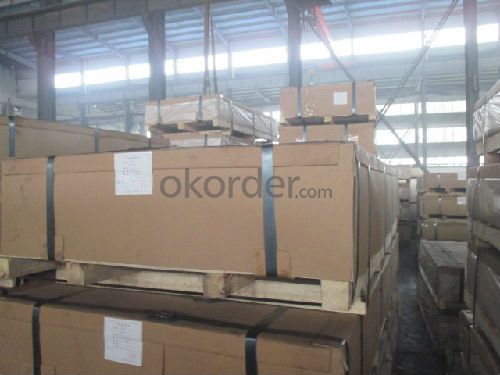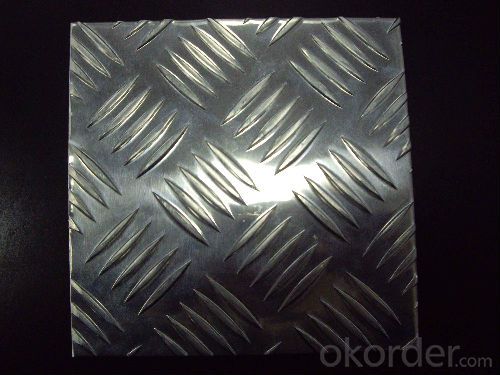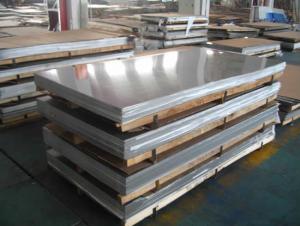Stainless Steel Plate With Best Price In Our Warehouse
- Loading Port:
- Shanghai
- Payment Terms:
- TT or LC
- Min Order Qty:
- 5 m.t.
- Supply Capability:
- 4000 m.t./month
OKorder Service Pledge
OKorder Financial Service
You Might Also Like
1.Structure of Product Description
there are many different grades, such as: 200 series, 300 series, 400 series, 900series, etc. The detailed grade are as follows: 201, 202, 301, 304, 316, 410, 420, 430, etc.ok, we are one of biggest group enterprise with best-selling price and best quality for stainless steel slab, please contact me if you are interested in any of items towards stainless steel sheet.
The surface is including 2B, BA, Mirror Finish, Checkered, etc.
2. Main features of the product
a. Competitive price
b. Frist-Class Service.
3. Image.


4. Product detailed sizes:
1000mm*2000mm, 1219mm*2438mm,1220mm*2440mm, 1250mm*2500mm,1500mm*3000mm, etc.
5. FAQ:
What is the quality standard?
---Usually our standard is GB3880-2006 or else.
What is the width range?
---It is from 1000mm to 2500mm, etc.
What is the length range?
---It is from 2000mm to 6000mm, etc.
What is the MOQ for your products yet?
---Normally it is around 3 tons/each size.
How many tons did you export in one year?
---Normally it is around 9000 tons totally.
Where is your client from?
---Normally it is from Japan, USA, ENGLISH, SINGAPORE, ETC.
What is your mainly products?
---Normally they are stainless steel sheet, stainless steel coil, stainless steel checkered sheet, stainless steel mirror finished sheet, color coated stainless steel sheet, etc.
- Q:How do you determine the hardness of stainless steel sheets?
- To determine the hardness of stainless steel sheets, several methods can be used. One common method is the Rockwell hardness test, which measures the depth of indentation on the surface of the material. In this test, a diamond cone or steel ball is pressed into the sheet at a specific load, and the depth of penetration is measured. The Rockwell hardness value is then determined based on the depth of the indentation. Another method is the Vickers hardness test, which uses a diamond indenter to create a square-shaped indentation. The size of the indentation is measured and converted into a hardness value. This method is often used for thin materials like stainless steel sheets. Brinell hardness test is another technique that can be used. It involves applying a known load to the material using a hardened steel ball and measuring the diameter of the resulting indentation. The hardness value is then calculated based on the applied load and the diameter of the indentation. In addition to these mechanical tests, there are also non-destructive methods like ultrasonic hardness testing and magnetic hardness testing. Ultrasonic testing measures the speed of sound through the material, which is then correlated to hardness. Magnetic hardness testing measures the magnetic properties of the material, which are influenced by its hardness. Overall, the hardness of stainless steel sheets can be determined using various methods depending on the specific requirements and characteristics of the material.
- Q:Are stainless steel sheets resistant to galvanic corrosion?
- Indeed, galvanic corrosion can be prevented by using stainless steel sheets. When dissimilar metals encounter each other in the presence of an electrolyte like moisture or saltwater, galvanic corrosion ensues. The process involves one metal acting as an anode and the other as a cathode, resulting in the transfer of electrons and corrosion of the anode. Stainless steel, an alloy that incorporates chromium, possesses a passive oxide layer on its surface. This layer serves as a protective shield, impeding the transfer of electrons and effectively combatting galvanic corrosion. The chromium in stainless steel reacts with oxygen in the atmosphere, generating a thin, invisible, and self-rejuvenating layer of chromium oxide. This exceptional layer provides outstanding corrosion resistance, rendering stainless steel highly resistant to galvanic corrosion when combined with other metals. Nevertheless, it is worth noting that the level of corrosion resistance can vary depending on the specific grade and composition of stainless steel employed. Some stainless steel alloys, such as Type 316 stainless steel, offer even greater resistance to galvanic corrosion due to the inclusion of molybdenum, which bolsters its corrosion resistance in aggressive environments. In conclusion, stainless steel sheets typically exhibit remarkable resistance to galvanic corrosion due to the presence of a passive chromium oxide layer on their surface. This makes stainless steel an excellent choice for applications where galvanic corrosion poses a concern, such as marine environments or when in contact with dissimilar metals.
- Q:Can stainless steel sheets be used for cladding?
- Indeed, cladding can utilize stainless steel sheets. The preference for stainless steel as a cladding material stems from its robustness, ability to withstand corrosion, and visual allure. It is frequently employed in the external cladding of structures, including facades, canopies, and curtain walls. Stainless steel sheets provide an elegant and contemporary look while furnishing defense against severe environmental circumstances. Furthermore, stainless steel cladding necessitates minimal upkeep, boasts an extended lifespan, and can be effortlessly cleaned, rendering it a pragmatic selection for both residential and commercial purposes.
- Q:304 stainless steel has several advantages, a few big advantages, the more concrete the better
- 304 stainless steel advantages:1. environmental sanitation: put an end to red water, blue green water, and hidden water problems, no peculiar smell, no harmful substances, keep the water quality pure, lead free, harmless to human health.2., wear resistance: beautiful surface, clean and bright, long lasting, no scratches, never rust, never break. 3., low temperature: kitchen, bathroom, stainless steel water pipe, faucet angle valve will never break.4., thermal expansion and excellent insulation performance: stainless steel tube has expansion, cold contraction, slow insulation performance.5. authority certification: stainless steel metal element precipitation than WHO and European drinking water act standard value of 5% is still lower.
- Q:What is the coefficient of expansion of stainless steel sheets?
- The coefficient of expansion of stainless steel sheets can vary depending on the specific grade or alloy of stainless steel being used. However, in general, stainless steel has a coefficient of expansion ranging from 10.8 to 16.3 x 10^-6 per degree Celsius. This means that for every degree Celsius increase in temperature, stainless steel sheets will expand by approximately 10.8 to 16.3 millionths of their original length. It is important to note that different grades of stainless steel may have slightly different coefficients of expansion, so it is always recommended to consult the manufacturer or specific material specifications for accurate information.
- Q:What is the minimum thickness of stainless steel sheets available?
- The minimum thickness of stainless steel sheets offered may differ based on the manufacturer and the particular grade of stainless steel employed. Typically, the thinnest stainless steel sheets offered range from 0.4mm to 0.5mm. Nevertheless, it is worth mentioning that certain manufacturers might provide thinner sheets, like 0.3mm, although these may be more specialized or not as readily accessible. If you have a specific thickness requirement for your project, it is advisable to seek guidance from stainless steel suppliers or manufacturers to ascertain the available choices.
- Q:How to calculate the weight of stainless steel plate?
- Stainless steel not only refers to a stainless steel, but more than one hundred kinds of industrial stainless steel, the development of each kind of stainless steel in its specific application areas have good performance. The key to success is to find out what the purpose is, and then determine the correct type of steel.
- Q:Are stainless steel sheets suitable for water treatment facilities?
- Yes, stainless steel sheets are highly suitable for water treatment facilities. Stainless steel is corrosion-resistant, durable, and can withstand harsh conditions often found in water treatment processes. Additionally, stainless steel sheets are hygienic, easy to clean, and do not react with water or chemicals, making them an ideal choice for such facilities.
- Q:Can stainless steel sheets be used in manufacturing processes?
- Yes, stainless steel sheets can be used in manufacturing processes. Stainless steel is a highly versatile and durable material that is commonly used in various industrial applications. Due to its corrosion resistance, strength, and heat resistance properties, stainless steel sheets are ideal for manufacturing processes that require a material to withstand harsh conditions, such as chemical processing, food and beverage production, pharmaceutical manufacturing, and automotive manufacturing. Stainless steel sheets can be formed, cut, welded, and machined to suit specific manufacturing requirements, making them a popular choice in the industry.
- Q:Can stainless steel sheets be used for air conditioning systems?
- Yes, stainless steel sheets can be used for air conditioning systems. Stainless steel is a durable and corrosion-resistant material, making it suitable for use in air conditioning systems where it may be exposed to moisture and varying temperatures. Additionally, stainless steel's high strength-to-weight ratio makes it ideal for constructing components such as ductwork, evaporator coils, and heat exchangers in air conditioning systems.
1. Manufacturer Overview |
|
|---|---|
| Location | |
| Year Established | |
| Annual Output Value | |
| Main Markets | |
| Company Certifications | |
2. Manufacturer Certificates |
|
|---|---|
| a) Certification Name | |
| Range | |
| Reference | |
| Validity Period | |
3. Manufacturer Capability |
|
|---|---|
| a)Trade Capacity | |
| Nearest Port | |
| Export Percentage | |
| No.of Employees in Trade Department | |
| Language Spoken: | |
| b)Factory Information | |
| Factory Size: | |
| No. of Production Lines | |
| Contract Manufacturing | |
| Product Price Range | |
Send your message to us
Stainless Steel Plate With Best Price In Our Warehouse
- Loading Port:
- Shanghai
- Payment Terms:
- TT or LC
- Min Order Qty:
- 5 m.t.
- Supply Capability:
- 4000 m.t./month
OKorder Service Pledge
OKorder Financial Service
Similar products
New products
Hot products
Related keywords






























